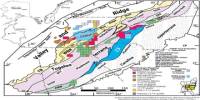The deflections of reinforced concrete beams and slabs are affected by a number of elements that must be fully taken into account during design and construction. These elements can be separated into two categories: parameters that were known before construction and elements that weren’t. It is shown that unknowable factors have a greater impact than those that were understood before to construction.
Additionally, by computing deflections using realistic maximum and minimum values for parameters, the possible deflection variation of reinforced concrete beams and slabs may be evaluated.
Factors Affecting Deflections of RCC Beams and Slabs
Following are the factors which affect deflections of flexural members (beams and slabs) in reinforced concrete structures:
- Errors in the deflection computation of flexural members
- Loading of flexural members
- Flexural stiffness
- Factors affecting fixity
- Construction variations of flexural members
- Creep and shrinkage in flexural members
Errors in computation of deflections for beams and slabs
Since computations are often done by a human, disparity between estimated and real deflections can primarily be attributed to computational mistakes. The following sections explore and explain a number of these computational blunders. To get at the ultimate deflection result, various deflection calculation steps must be taken into account. Any error in any step could have a considerable detrimental effect on the final result. For example, when error probability is 1% in each step, the probability of errors in the final result is around 10%.
Moreover, it is considered that the computation errors between 25 – 50% are uncommon. Applying a computer program could shorten and simplify the deflection calculating process. The program should account for the majority of the factors that influence flexural member deflection and credibly compute and predict structural deflection under a variety of circumstances with high accuracy.
In order to gain and improve sound judgment skills, it is crucial that practical engineers compare calculated and performance deflection. Another cause of mistakes in the deflection calculation of beams and slabs (flexural members) is the accidental use of calculated loads or moments rather than actual service loads or moments. Finally, under the loading conditions under consideration, ultimate moments derived from moment coefficients of pattern load may be used in place of actual moments.
Loadings on RCC Beams and Slabs
There are numbers of factors based on loads which affect deflections of RCC beams and slabs, such as:
- Because the elastic and rupture moduli of concrete vary with age and thus alter instantaneous deflection, it is crucial to consider the loading history.
- Use actual loads instead of loads that considered in strength design. Moreover, it is common to find that live loads determined by building codes are never reached in real situations.
- Consider the proportion of long term loading versus temporary loading. Permanent live loads create higher creep deflection than transient live loads because creep deflection occurs when loads are sustained for a while. Additionally, some live loads may remain for an exceptionally long time and be the cause of significant deflection, whereas others that exist for a short time may not result in appreciable long-term deflection.
- Correctly evaluate the live load; when actual service live load is less than design live load, applied moment to cracking moment ratio will be smaller. This could result in a higher effective moment of inertia, which would lead to less dead and live load deflection.
- Consider redundancy; For example, when a reinforced concrete element crosses the main span, it may be subject to a number of loads. As a result, the moment is reduced, which lowers the deflection of the member under discussion.
Flexural Stiffness of RCC Beams and Slabs
It is recommended to employ both actual modulus of elasticity (Ec) and modulus of rupture (fr) due to their influence on deflection. American Concrete Institute Code specify the ratio of fr?(fc’)0.5 = 7.5 however depends on number of researches the ratio is changing from 7.5 up to 10. If the modulus of rupture is raised by a third, the moment of inertia will rise by 75%. The computed deflection is higher than the actual deflection because the ACI Code value is conservative.
Furthermore, it is suggested to employ effective moment of inertia at all loading stages based on the quantity of cracking at that stage in cases where early cracks caused by construction loads are not permitted. In addition, if the ultimate load occurs during construction, just one flexural stiffness computation is necessary to perform and only one cracking condition that is, when the maximum load is reached is taken into account. The most intense loading conditions occur during construction when shoring loads from above stories and other construction loads are put on the structure. Site observations confirm this assumption and also offer a simpler and quicker calculation.
Furthermore, when a structure is fully examined and particularly where a sizable discrepancy exists between the as constructed location and prescribed position, the actual placement of reinforcement as built should be used. When computing the gross and cracked moment of inertia, use the actual location and quantity of compression reinforcement. For estimating the cracked moment of inertia, use the actual location and tension reinforcing amount.
Last but not least, consider flange effect even if they are small. Both uncracked and cracked moment of inertia is small and calculated deflection is high when rectangular section is employed rather than T-section.
Finally, instead of averaging end and mid span stiffness, make a credible evaluation of the contribution of end region stiffness to the overall stiffness. Application of mid-span stiffness might yield acceptable results for a typical and straightforward computation technique, but accuracy for an extended calculation could be improved by integrating end region stiffness.
Fixity of RCC Beams and Slabs
Since support rotation can produce a movement that is greater than the member’s flexural deflection, support rotation in cantilever structures should be taken into consideration. Additionally, depending on the weight and the size of the back span, rotation may result in rising or lowering towards the conclusion.
Additionally, consider the nearby restraint that is offered by parallel members that are not loaded via the tensional stiffness of the supporting beams. In addition, instead of using the suggested prismatic elements, determine the moment distribution based on the member’s actual stiffness and loading conditions.
Another aspect that ought to be taken into account is allowing for joint stiffness unless the joints are robust or have sufficient anchoring support. This phenomenon is comparable to the cantilever’s support rotation effect. There are no effective analytical tools that address this issue.
Finally, because end spans are sensitive to assumptions of moment at crucial parts, they must be carefully evaluated. Even if there are more steel bars available to bear a higher moment, if the end support is predicted to have little stiffness, the positive moment in the end support is considerable and as a result, the calculated deflection is substantial. Because of this, designers may choose to limit deflection rather than meet strength requirements by using larger beams and greater reinforcing in the end spans.
Due to the significant impact of moment distribution on deflection variation, processes for shoring and reshoring should be accurately managed in addition to the aforementioned parameters. Inadequate procedures could lead to situations that could be more severe than those for which the structure is built.
Construction Variations of Flexural Members
In general, the designer’s only real options for addressing construction variations are to establish tolerances and procedures. ACI 117-10 provides tolerances on steel installation, concrete outline, and material properties. The effect could be very great when maximal variations are used in the same direction to determine deflection.
However, it is likely that variants cancel each other out and that their impact is little unless they have a strong positive influence on one another. Numbers of extremely severe variations in construction which affect deflections of RCC beams and slabs are explained in the following sections:
- Concrete outline tolerances could lead to smaller or larger member compare with specified element.
- As a consequent of gravity, concrete cover might thinner than determined. Cracked moment of inertia is increased as effective depth is increasing. Gravity effect leads to increase top bar cover and decrease effective depth and moment of inertia.
- Concrete modulus of rupture is more changeable than compressive strength. It might vary along the member length and is likely to reach average in its influence on deflection.
- Concrete’s compressive strength may exceed specifications by up to 15%, and its elastic modulus may rise by 7%. If the structure is loaded before it reaches design strength, detrimental effect on deflection could be more serious than demonstrated by lower concrete strength because creep coefficient can be up to 50% larger for stress/ strength ratios fc / fc’ > 0.50 than for fc / fc’ < 0.50. Therefore, it is important to avoid loading deflection-sensitive structures before they reach design strength.
- When the element is cracked, the effect would be proportional if the bottom bar numbers are less or greater than those specified.
Creep and shrinkage in flexural members
Age of loading, minimum thickness, relative humidity, volume to surface ratio, cement concentration, slump, aggregates, air content, ambient temperature, and admixtures are just a few of the variables that can effect creep and shrinkage.
















